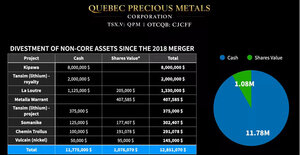Phil McPherson: Yes. In the exploration and production (E&P) space as a whole, it's a pretty simple business model. The size of the company is basically a reflection of the ability to accelerate that business model. And your ability to execute and meet timelines usually has just as much of an impact on your market cap as the success or the failure of the actual oil and gas (O&G) play. I'm covering many California companies, including Berry Petroleum (NYSE:BRY), Plains Exploration & Production (NYSE:PXP) and this small oil producer that I stumbled across, NiMin Energy Corp. (TSX:NNN). I think they all have the same type of idea. But in terms of how they trade, every company is in some ways going to trade as does the commodity. So you're going to go up and down on certain days because oil's up and oil's down. I used to joke with people that you could announce the best well in the world, but if oil prices are down, your stock is going to go down. A small cap of $100 million to $500 million trades more on the net asset value (NAV) or the value of the perceived potential of your properties. When you get to that $500 million– $2 billion area, you start looking at a multiple of EBITDA (earnings before interest, taxes, depreciation and amortization) or cash flow multiples. When you get to be large cap, you're really more of an earnings story; then you start thinking about P/E ratios and cash flow ratios.
TER: Do inflationary pressures point towards higher oil prices?
PM: With the economy recovering, and as more people feel that the double-dip recession is not going to happen, oil prices are tending to stay stronger. However, it seems to me the tail is wagging the dog right now, with the U.S. dollar going down and the price of bonds being up, and the yield being extremely low. To me, it has more to do with the price of oil than necessarily the pure supply and demand fundamentals, because we still have excess supply of oil via OPEC. If you're bullish on oil or bullish on the economy, then you use those dips as opportunities to gain more exposure.
TER: What about inflationary effects on margins?
PM: The biggest inflationary costs we're seeing right now are on unconventional completion services, like fracking crews, cementing and pressure pumping. But as with any business, when the demand is there and the visibility is there, entrepreneurs rise up to the challenge because they know they can make money. I think you're going to be surprised that in 2011 the likes of Halliburton Co. (NYSE:HAL) and Schlumberger Ltd. (NYSE:SLB), as well as lot of other smaller companies, are going to have more crews out working. There's going to be enough demand there. It's all a function of oil prices, and as long as they are in this relative range, people are going to continue to drill these wells. I don't think margin makes as much of an impact as the NAV that you can grow with these companies via drilling these wells and growing reserves.
TER: I know it's not your area, but would you expect the vertically integrated oil companies and the oil field service providers to benefit more from an inflationary environment than the E&P companies?
PM: I think the oil field service guys will definitely benefit because they're going to put more crews to work. They're going to hire more people. They're going to be able to generate more revenues and thus make more money. I've always stayed away from the vertically integrated guys. The old joke in the oil patch is that you never make any money on refining. That business has a very weird dichotomy, and it just doesn't seem like these guys really ever make that much money. So I don't know if it really affects them as much, but they can pass higher prices along to the consumer.
TER: Phil, do investors have more leverage with E&Ps than they do with these other kinds of companies?
PM: I've always believed that they do. The argument against that concept used to be that if you're a service company, you don't have the volatility of oil and gas prices to deal with, and you therefore don't get hurt as much. I would argue that now they trade together. When oil prices go up everybody goes up, and when they come down everybody comes down. Where the real difference is, I think, is in value creation. That means an oil company can literally go out and change the value of the entire company in one day with one wellbore. It can make one discovery in one field, and set in motion something that can last for 10 years. You don't get that type of a big upside surprise from a service company overnight, but an E&P company can really hit a home run and change the fates of the company and the shareholders overnight.
TER: But the risk is greater in E&P.
PM: Well, for that perceived dry hole risk. Or if they're betting everything on one well, but I think we've gotten away from that. I would say 90% of companies right now are involved in more than one type of project. You might be in the Bakken and the Eagle Ford and the Niobrara Formation or whatever. So you don't have that one-trick pony. There are still some that are pure plays, and I'm looking at one now. Now, in general, it seems like the unconventional plays have taken out some of that old-time wildcatter spirit—where you're going to be either hero or zero. Some of the offshore guys like the McMoRan's (McMoRan Exploration Co. (NYSE:MMR)) of the world, with their deep shelf stuff, are kind of unique. But all in all, I don't think there is as much of that kind of mentality as there used to be.
TER: What is the minimum dollar price per barrel that oil has to maintain for a small-cap E&P company to make money?
PM: That's not going to be necessarily dependent upon a company's market cap. It's really going to be about the project. You have certain fixed costs, like your general and administrative (G&A), but it's really more on a project-by-project basis. The highest cost oil in the world right now is probably the tar sands, where you probably need $50/barrel to break even. If you're in the deepwater Gulf of Mexico, there are barriers because of the economics of infrastructure, and you're not going to develop a small discovery there, so your threshold for commerciality is much higher. I've seen companies with $150 million market caps that have better margins than companies with $6 billion market caps. It just depends on the amount of leverage a company has and what play it's in. Right now you can be in an oil play and your margins are going to be much higher. But the gas guys are really hurting right now. At $4 per thousand cubic feet equivalent (Mcfe), it's pretty hard to be making any money; and, in a lot of cases, you're actually destroying shareholder value by continuing to drill.
TER: Phil, when you're doing due diligence on a new company that you might add to your coverage universe, what's the first thing you look at? Give me an example or an anecdote.
PM: If something new pops up on the screen, like a brand-new company, probably the first thing I'm going to do before I call anybody is see what the capital structure of the company looks like. That's because I think we've all learned, coming through this last couple of years, with the credit markets tightening and things of that nature, is that no matter how great a company looks, or what it has, or however great the management team is, if it's not set up properly to succeed, then it's already put on its own handcuffs.
I've always been kind of a stock picker, and I know that capital structure and how your operations are funded are sometimes more important than the operations you're going to fund. An example would be NiMin Energy, which I recently initiated coverage on. When it went public, it didn't raise as much money as was desired. The company was eventually able to get a term loan to replace some of their short-term debt. It now has a five-year window of opportunity to take that money and go out and execute, grow production, grow reserves, grow value. Now it doesn't have any short-term financing needs, so if the [debt or equity] market's not there, the company won't be backed up against a wall. I think people have learned that you don't want to be a victim of the markets. You want to be able to pick and choose when you raise capital, and raise it on your terms, versus letting the market dictate it. I believe that is one thing that most people overlook. Right now, I can buy NiMin's proved reserves for around $9 or $10/barrel in the ground. Oil's trading at $90, and there's obviously a huge gap between those two numbers. If you take into account inflation and the declining dollar, you have a unique way to think of resources. It's almost like buying gold, but you're actually buying a company's reserves at an attractive price.
TER: What other small-cap companies have a proper capital structure and management?
PM: I'll just stick with the California theme and then go elsewhere. One of the more interesting names now, and possibly in 2011, that will have a lot of people scratching their heads is Venoco, Inc. (NYSE:VQ). A Denver-based independent, but all its assets are based in California. It's 50% oil, 50% natural gas. But it has this emerging play called the Monterey Shale. The Monterey Shale is the source rock in California for a lot of the legacy properties. The founder of that company believes he can use horizontal drilling and modern-day completion technologies to unlock a lot of hidden reservoirs in California.
TER: That's just a hard way to get oil, isn't it?
PM: California is actually pretty fortunate in that our rock quality out here is very good. Although the formation is called is the Monterey Shale, the word "shale" is in quotation marks because the porosity and permeability of the rock are 10–15 times better than the Bakken Shale. So, rather than having to do these long laterals with 30- or 40-stage fracks, which cost millions of dollars, you can do a long lateral into this better rock and you're going to get more oil out of it. The analogy I use is that it's like pulling the tab on a shaken Pepsi or Coke can. Once the hole is opened, the oil flows out naturally as it's under pressure; so, when you pull that tab, it should flow relatively naturally through the wellbore and back up the wellbore. Then, once the initial pressure drops, you can pump that oil out of the reservoir.
TER: What would be a market-moving event for Venoco?
PM: The company stubbed its toe a little bit. Its first Monterey Shale well encountered a water zone, and it watered out. The stock went from $21 to $15 and is starting to recover here again. Its second horizontal well is done, and is in production. The company hasn't released any results on it. Its third horizontal well has just finished drilling, and the fourth one is getting ready to start drilling. So, by the first quarter of 2011 when they report year-end reserves, you should also have data on two or three more wells. I think as people see the data and start to believe in it, the floodgates will open and the stock will move materially higher. To put things in perspective, right now when we talk about buying a barrels in the ground, Venoco's proved reserves are valued at about $16–$16.50/barrel in the ground. We talked about NiMin being at $9/barrel, which is probably one of the lowest valuations I can find in my group and one of the reasons I like it. Venoco at $16.50 is in the middle of, or still slightly below, the group. The group right now is trading at north of $24/barrel in the ground from an oil-weighted perspective. The point being, investors are not paying a lot for the upside potential in the Monterey Shale. The company has amassed 150,000 acres. The fully undiscounted value of the Monterey could be a multiple of Venoco's current stock price. I like that type of risk reward and I think it should serve investors well in 2011.
One thing that may give Venoco legs is that OXY (Occidental Petroleum Corp. (NYSE:OXY)), the 800-pound gorilla out here in California, is running 10 rigs targeting the Monterey Shale in 2011. The company has actually gone so far as to say they think shale oil will be a top-10 business unit for OXY in the next 10 years. For a $70-billion dollar company to say that is a pretty bold statement. The last time I checked, OXY had zero debt and was buying back stock. A lot of people don't realize that OXY is one of the largest oil producers in California and in Texas. So while news from Venoco will move its stock, news from OXY also could move Venoco's stock, because from a small-cap investor's standpoint, you're not going to buy OXY to make 5% or 10% of your money. You'd buy Venoco, which could potentially provide a two-, three- or four-bagger.
TER: Was there another one that had the right characteristics?
PM: Yes, there's one company that I recently downgraded. You know, the life of an analyst is interesting because you have to make long-term decisions and you also have to have short-term impactful calls. So, in January this year (2010), I actually initiated on a company called Magnum Hunter Resources Corp. (NYSE.A:MHR), which is a second reincarnation of Magnum Hunter, at $2 a share, and it recently hit my price target of $6 a share. It went all the way almost to $6.50. So I downgraded it from a buy to a neutral on valuation, stating that the stock had made a great move this year. We made investors a lot of money and at this price, I wouldn't commit new capital to it. West Virginia is a very natural resource favorable environment, with all the coal and drilling that's been going on there for hundreds of years. Magnum Hunter is in the West Virginia window of the Marcellus Shale. It's one I'd be looking at buying on a dip.
TER: Magnum Hunter is up about 250% over the past year. Congratulations on that one.
PM: Yeah. Not bad. Thank you.
TER: So, what other characteristics suit your investment preferences?
PM: My newest foray has been looking at more international opportunities. I cover Houston American Energy Corp. (NYSE.A:HUSA), a company that is getting ready to drill some pretty high-impact exploration wells in Colombia, of all places. I initiated that one at around $3.50 or $4, and it's at $17 today. It's been a solid performer though we're waiting for drilling results. The company is going to start drilling in the first quarter. Houston American is like the old analogy that you can buy the smallest house in the best neighborhood and the price of your house will go up, right? Well, it's got this block in Colombia and it's surrounded by all the big boys. A Canadian company has been drilling wells that have had initial production rates in excess of 10,000 barrels a day. For onshore exploration, you haven't seen anything like that in the United States in 50 years. We say this is like being in Texas 50 years ago when people first started to drill some of the Spindletop stuff and things like that. It's just the fact that Colombia was such a bad place to be for the better part of the 20th century.
TER: You see this company as low hanging fruit?
PM: Yes, because there haven't been a lot of wells drilled. People were scared they were going to get kidnapped. Now, in the last seven or eight years the country has had a democratic president that pushed the terrorist FARC out of the country, improved the fiscal regime and improved the oil and gas business. This guy came in and formed an entirely new division of the oil and gas ministry and stopped all the automatic back ends (royalties). There's a public company now, called Ecopetrol S.A. (NYSE:EC; TSX:ECP), that has to compete in the licensing rounds along with everybody else. The entrepreneurial spirit has been brought back.
TER: You have an accumulate rating on Rosetta Resources Inc. (NASDAQ:ROSE). You said in a note that it is divesting nine core assets that would ultimately impact operating margins in a positive way. It is converting from a natural gas to an oil company. What does this portend for investors?
PM: They used to be just a conventional player, mostly in natural gas. A new CEO, Randy Limbacher, came in about two years ago from Burlington Resources' exploration group, and he brought in a lot of his old guys from Burlington—good old-fashioned oil and gas guys. The company started looking at basins and places where they wanted to be. They ended up in the Eagle Ford Shale, and they were one of the first to drill a well there. They acquired big blocks of acreage, the major one being the Gates Ranch, which is about 29,500 net acres. So, now they've got 10 years of drilling inventory just in that one property.
TER: We've mostly been talking about growth stories. Are there any deep value plays in your universe?
PM: Well, you know, I don't look for companies that are just deep value. They need to have a little bit of growth. But the one that pops up to me is an offshore company called W&T Offshore Inc. (NYSE:WTI). It's only grown maybe 10% or 15% per year. But at $16 a share right now, the company is trading at less than two and one-half times cash flow. So that's relatively cheap. I would call that a value story. They're looking at taking advantage of this post-Macondo operating environment, buying more assets in the Gulf if they can get them at attractive prices. They are acquiring and exploiting them, and they continue to generate huge amounts of cash-flow.
TER: There was one more story on your coverage list that was zero-debt: Evolution Petroleum Corporation (NYSE:EPM).
PM: Yes, that would be a sort of deep-value company, and it's basically a play on oil. But its primary asset is a revisionary working interest in an override on the Delhi Field. It bought this field all-in for about $6 or $7 million, and sold it to Denbury Resources Inc. (NYSE:DNR) for $50 million. So Evolution got six or seven for one on its money there, and then kept a 7.2% overriding royalty on a 25% backend working interest. Denbury had to build a $200 million pipeline to start injecting CO2, which it started doing in the beginning of 2010. Now we're getting first response, and those reserves are booked as proved. This company has an enterprise value of $160 million. In the Delhi Field alone, there are about 12 million barrels. So it's about $13/barrel to own this company with zero debt and 90% oil.
TER: Is there anything you'd like to leave with our readers today?
PM: My closing thought is that what always amazes me about investors, particularly in the oil space, is how scared they can get when oil goes down. They feel like Chicken Little, like the sky is falling. To me, if you believe in the global economy and you understand the supply and demand dynamics with China and India, and that their economies are growing at such rapid paces, it's very hard to poke holes in the oil thesis. Maybe oil prices won't go to $100 or $150 overnight; but, over the longer term, they're going to continue to trend higher. My advice has always been that when some unemployment number or something comes out and scares the market, and oil's down $2 or $3, those are the best days to sharpen your pencil and buy your best companies.
TER: Phil, I've enjoyed talking with you. Thank you.
PM: Thank you.
Philip McPherson joined Global Hunter Securities in June of 2007 as a senior equity research analyst in the firm's energy group. Prior to joining GHS, Mr. McPherson was director of research at C. K. Cooper & Company, a boutique investment-banking firm located in Irvine, California, which focused exclusively on small-cap exploration and production companies. In his role at C. K. Cooper, Mr. McPherson was responsible for new initiations of E&P companies; additionally, he generated the firm's macroeconomic analysis in relation to oil and natural gas price forecasts, which generated the firm's price decks. Mr. McPherson was rated a five-star analyst by Zacks in 2002, 2003, 2005 and 2006. Prior to joining C. K. Cooper, Mr. McPherson was a partner in Mission Capital, which was acquired by C. K. Cooper in 2001. Mr. McPherson began his career in the securities industry at Mission Capital in March of 1998 as a retail stock broker. He graduated from East Carolina University with a BA in economics.
Want to read more exclusive Energy Report interviews like this? Sign up for our free e-newsletter, and you'll learn when new articles have been published. To see a list of recent interviews with industry analysts and commentators, visit our Expert Insights page.
DISCLOSURE:
1.) George Mack of The Energy Report conducted this interview. He personally and/or his family owns shares of the following companies mentioned in this interview: None.
2.) The following companies mentioned in the interview are sponsors of The Energy Report: None.
3.) Philip McPherson: I personally and/or my family own shares of the following companies mentioned in this interview: Venoco and Evolution Petroleum. I personally and/or my family am paid by the following companies mentioned in this interview: None.








































